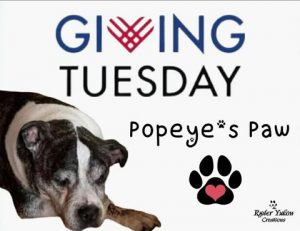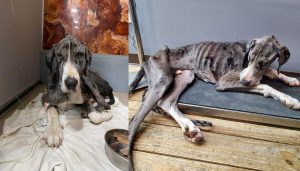 Megaesophagus in Domestic Animals
Megaesophagus in Domestic Animals
Megaesophagus (ME) is not typically a single disease. It is generally considered a combination disorder in which the esophagus, the tube that carries food and liquid between the mouth and stomach, dilates and loses its ability to move food into the stomach. When esophageal motility is decreased or absent, food and liquid accumulate in the esophagus and have difficulty getting into the stomach.
ME is a heartbreaking diagnosis, and one not fully understood in the veterinary community. But it is NOT an automatic death sentence. Some ME pets, with treatment, live long and happy lives. Others do not, unfortunately, despite tremendous care from their human parents, competent veterinarians, special diets, and a variety of medications and even supplements. Still others “grow out” of ME for reasons that are unclear. Importantly, in some pets, ME is caused by underlying conditions that are treatable and can completely resolve following treatment.
Basically, when the animal’s esophagus is functioning normally, food in the mouth stimulates nerves that send signals to the swallowing center in the brainstem, which in turn stimulates the swallow reflex. Along the various nerve pathways, there are several places at which a malfunction can cause megaesophagus. Regurgitation is the most common sign of megaesophagus.
Regurgitation is NOT the same as vomiting, and a dog’s or cat’s regurgitation is often recognized by a thick, white foam.

There are two types of Megaesophagus:
Congenital megaesophagus (born with the condition) is developmental and causes regurgitation starting at weaning, when puppies and kittens begin eating solid food.
Acquired megaesophagus occurs later in life, in young adults and middle-aged animals.
Approximately 25% of dogs with acquired megaesophagus have myasthenia gravis. While the symptoms are similar to congenital myasthenia gravis, the cause, testing, and treatment are different.
Obstructive disorders may cause megaesophagus by physically blocking the esophagus from functioning normally. In these cases, the muscle and nerves of the esophagus are normal, but chronic distention directly in front of the obstruction causes muscle dysfunction.
Examples of obstructive secondary megaesophagus include:
Foreign bodies stuck in the esophagus can prevent normal swallowing.
Cancer in or around the esophagus can also partially block the esophagus.
Vascular ring anomalies are caused by abnormal development of vessels near the heart. Fetal vessels that should disappear by birth remain intact, encircling and constricting the esophagus.
 Diagnosis
Diagnosis
Pets with megaesophagus typically regurgitate food and water. Their food does not get into the stomach to be digested, so they do not get the nutrients they need. If they are young, this lack of nutrients causes poor growth and development.
If they develop acquired megaesophagus as adults, then they will lose weight. They may hyper-salivate and “gurgle” when they swallow. In some individuals, you can actually see a bulging of the esophagus at the base of the neck and touching that area may be painful for the dog. These pets may act hungry but then pick at their food or not eat at all, to avoid the coughing and gagging they associate with eating.
Additional symptoms of Megaesophagus may include:
Bad breath
Signs of pneumonia from aspirating food and/or liquid–fever, rapid breathing, abnormal lung sounds, coughing. This is called AP or Aspiration Pneumonia. It is very important to recognize these symptoms and to seek immediate medical attention for your pet, because while treatable with antibiotics, if untreated, AP can be fatal. And unfortunately, ME pets can often contract AP several times throughout their lives, even if an earlier episode was fully resolved.
Muscle weakness and wasting from slow starvation
ME can be diagnosed with a simple x-ray but a more thorough one is done by a barium swallow study. If this is a new puppy or a rescue, and you don’t have a complete medical history, PRAA or Persistent Right Aortic Arch should be ruled out. This is a vessel coming from the heart that should have dissolved before the puppy was born but remains to strangle off the esophagus. There is a surgery to correct this anomaly.
Other test modalities include:
Radiology: Megaesophagus is routinely diagnosed through x-rays. The esophagus is not normally seen on x-rays, but the mass of food and/or air can be detected, which may lead to a diagnosis. X-rays can diagnose megaesophagus but do not always determine the cause.
Fluoroscopy: This test is similar to an x-ray but is performed in real-time during swallowing to assess the esophagus’ ability to contract.
Other tests: Esophagoscopy (video scope into the esophagus), blood tests, tests for various neuromuscular and endocrine diseases, and muscle biopsies may all be used to determine the underlying cause of megaesophagus.
Best to Test: If ME came on suddenly and your dog was not born with it, it is always wise to test for an underlying disease that could have caused the ME. In about 25% of the cases, Acquired Myasthenia Gravis is the culprit. The thyroid should also be tested. Hypothyroidism is common in dogs and can cause ME. Addison Disease is called the Great Pretender and because of that, it is wise to test for it. There are many other diseases that can cause ME but they are the most common. You should blood test for all these conditions, to rule out or in, and there is treatment for each of these disorders. Many times, once the underlying/primary condition is treated, the ME becomes easier to manage and in some cases resolves altogether!
Responses and Therapies

Vertical Feeding: Gravity will be your friend with this disorder. A Bailey Chair is the easiest way to achieve this for many dogs but for some there are alternatives. Pet MD has an informative page on Bailey Chairs.
Baileychairs4dogs.com manufactures quality Bailey Chairs, as well.
Neck Hug: Elevation of the head is important for these dogs. When they lay down often times saliva will collect in the esophagus. It causes a dog to gag, cough and sometimes regurgitate the saliva back up and out. When you keep the dogs head elevated it keeps everything moving in the right direction. There are cloth, polyester filled ones on the market you can purchase. There are inflatable e-collars on Amazon and at your local pet store. Sometimes they are called “recovery collars,” and can work very well. They are not, however, a substitute for a Bailey chair, special diets and supplements as needed, and veterinary care.
Food: We don’t recommend a specific brand of dog food here. Your vet may recommend a food that is low in fat contents, because fat is more difficult to digest. Your vet may recommend a prescription food depending on your dogs diagnoses. Food consistency is important to get just right, which does takes some trial and error, and perhaps experimentation. Some pets need a slurry (more on the liquid side); others need something thicker with a milkshake-like consistency. Others do well with dog food that is rolled in *small* balls. For this, have your dog point his nose to the ceiling and drop from above their head, one ball at a time. This way, they aren’t chewed but rather swallowed whole. More recipes and a free cookbook on the website: caninemegaesophagusinfo.com under Resources.
Water: Most but not all ME dogs have issues with plain water. But you can always add water to their food and blend it. Knox blocks, gelatin made with chicken or beef broth or other approved fluid, are often tolerated and very helpful to keep your pet hydrated. Another option is to add Thick-It, which you can find in your local pharmacy, and just add the recommend amount to water. Some ME dogs do well with water before or after meals, while they are upright. Others have found that using a hamster-style water bottle, attached high enough that the dog has to reach up to drink, will help. You can also have your vet teach you how to do sub-cutaneous fluids right under the skin.
Medications: Some ME dogs do not require any medications at all. Here are some of the most common ones:
Metoclopramide, Cisapride and Bethanechol: These pro-motility drugs help stimulate the stomach muscles to move the food and fluid into the intestines faster. Bethanechol may have some effect in the esophagus.
Antacids: If your vet feels an antacid is appropriate, they may prescribe famotidine (Pepcid) or omeprazole (Prilosec) or another common one. Note that you should always speak to your vet about *any* over the counter medication before trying it with your pet.
Sildenafil: Often called “Doggy Viagra,” it’s used to help relax the lower esophageal sphincter (LES) is the muscle ring that leads to the stomach. This will help by allowing food and fluids to easily enter. It’s typically dispensed as a liquid at a certain time before meals.
Complications:
Aspiration Pneumonia (AP) can occur when a dog inhales food or fluids into the lungs. If you see the signs of AP, it’s vital to act on it quickly. Signs will vary, but most ME animals will be lethargic, have irregular breathing, not eating, a fever, and may present with a cough or runny nose. It is important to get medical attention quickly to avoid a more complicated and costly visit at the vets. Generally, vets will do chest x-rays and blood work, and if AP is diagnosed, antibiotic treatment will begin immediately, meaning 2-4 weeks on one or possibly two antibiotics to completely clear the infection. Three-view x-rays of the lungs and blood work are generally repeated just before, or coming off of antibiotics.
Esophagitis: Esophagitis can occur from acid reflux or repeat regurgitation or vomiting episodes. Small ulcers can form causing irritation of the esophagus. You might notice your dog gulping more, or refusing food. They might cough up the same telltale foamy substance. In this case, Sucralfate/Carafate is often prescribed to help soothe the esophagus. It should be given alone apart from food or meds, 1 hour before or 2 hours after food and meds, and helps by putting a protective coating on the esophagus. It comes in a soft tablet that can dissolve in a little warm water, and is then syringed gently in the cheek pocket of the mouth. It also comes in liquid form.
Gastroesophageal intussusception (GEI): This is a very unfortunate complication of ME. It’s important that ME parents are aware of it can have an informed discussion with your vet in the event it occurs. GEI can occur after a dog regurgitates or vomits repeatedly; their stomach telescopes or slides in the esophagus. There may be blood in the vomit, a typical sign that there is trouble brewing, and the dog will look distressed. It is an absolute emergency that requires immediate, emergency veterinary help. If you suspect GEI, call ahead to your vet and relate what you suspect is happening, because they may divert you to a clinic with more advanced equipment or surgical team. GEI can be surgically corrected, and the stomach tacked down at the same time to prevent further incidents.
ACKNOWLEDGEMENTS: VCA Animal Hospitals, The Upright Canine Brigade, PetMD, The Merck Veterinary Manual online, Popeye Gaier
RESOURCES:
https://vcahospitals.com/know-your-pet/megaesophagus https://caninemegaesophagusinfo.com/ https://www.petmd.com/dog/conditions/digestive/megaesophagus-dogs https://www.merckvetmanual.com/digestive-system/diseases-of-the-esophagus-in-small-animals/dilatation-of-the-esophagus-in-small-animals
 Tomorrow is “Giving Tuesday” and we’re asking all DOGGY LOVERS to help parents, & pups with Megaesophagus (ME), by making a donation to Popeye’s Paw .
Tomorrow is “Giving Tuesday” and we’re asking all DOGGY LOVERS to help parents, & pups with Megaesophagus (ME), by making a donation to Popeye’s Paw . ![]()
![]()
![]() THANK YOU!
THANK YOU!
 Megaesophagus in Domestic Animals
Megaesophagus in Domestic Animals


 Three courageous female soldiers in the U.S. Army – a Major, a First Lieutenant, and a Lieutenant Colonel, who are deployed in the Middle East found two helpless puppies abandoned outside their base gate. Moments later they knew they had to act fast to save the pups’ lives and reached out to us for help.
Three courageous female soldiers in the U.S. Army – a Major, a First Lieutenant, and a Lieutenant Colonel, who are deployed in the Middle East found two helpless puppies abandoned outside their base gate. Moments later they knew they had to act fast to save the pups’ lives and reached out to us for help. YOU CAN HELP!
YOU CAN HELP!


 Meet Rhett, a playful and affectionate 2-year-old Golden doodle looking for his forever family!
Meet Rhett, a playful and affectionate 2-year-old Golden doodle looking for his forever family!  As a violent storm battered an American base in a desolate part of Africa, U.S. Army Staff Sergeant Hope heard a desperate cry outside her door and when she looked out to investigate, a terrified kitten – Gizmo – rushed in and went into hiding. That was the moment she knew she had to act to save the vulnerable cat and reached out to Paws of War for help. Gizmo was abandoned near the base and with nothing around to survive on, her condition rapidly deteriorated. Staff Sergeant Hope and some other soldiers had been doing what they could – making a tiny lean-to for shelter, and sharing their food, but in a very remote area there wasn’t much available to them to help a struggling cat. Gizmo cowered in the makeshift shelter – afraid of the many predators lurking, and would only come out when she heard SSG Hope who she chose as her person. The sweet cat was so thankful to have someone be kind to her that she would bring gifts of bugs, leaves, and pieces of trash – all she could find to say “I love you” to brighten her hero’s day. In turn SSG Hope found comfort in having the little cat around but while she makes her smile, she can’t take her mind off the worry of knowing Gizmo can’t make it on her own when she returns Stateside and the fear in the young cat during the storm served as a reminder.
As a violent storm battered an American base in a desolate part of Africa, U.S. Army Staff Sergeant Hope heard a desperate cry outside her door and when she looked out to investigate, a terrified kitten – Gizmo – rushed in and went into hiding. That was the moment she knew she had to act to save the vulnerable cat and reached out to Paws of War for help. Gizmo was abandoned near the base and with nothing around to survive on, her condition rapidly deteriorated. Staff Sergeant Hope and some other soldiers had been doing what they could – making a tiny lean-to for shelter, and sharing their food, but in a very remote area there wasn’t much available to them to help a struggling cat. Gizmo cowered in the makeshift shelter – afraid of the many predators lurking, and would only come out when she heard SSG Hope who she chose as her person. The sweet cat was so thankful to have someone be kind to her that she would bring gifts of bugs, leaves, and pieces of trash – all she could find to say “I love you” to brighten her hero’s day. In turn SSG Hope found comfort in having the little cat around but while she makes her smile, she can’t take her mind off the worry of knowing Gizmo can’t make it on her own when she returns Stateside and the fear in the young cat during the storm served as a reminder. MOST ANIMAL SHELTERS IN THIS COUNTRY ARE PART OF A BROKEN SYSTEM, ONE THAT HURTS INNOCENT, HOMELESS ANIMALS MOST OF ALL. BUT IT ALSO HARMS HEROIC STAFF AND VOLUNTEERS.
MOST ANIMAL SHELTERS IN THIS COUNTRY ARE PART OF A BROKEN SYSTEM, ONE THAT HURTS INNOCENT, HOMELESS ANIMALS MOST OF ALL. BUT IT ALSO HARMS HEROIC STAFF AND VOLUNTEERS.